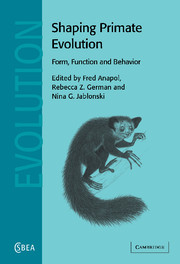Book contents
- Frontmatter
- Contents
- List of contributors
- Preface: shaping primate evolution
- 1 Charles Oxnard: an appreciation
- Part I Craniofacial form and variation
- 2 The ontogeny of sexual dimorphism: the implications of longitudinal vs. cross-sectional data for studying heterochrony in mammals
- 3 Advances in the analysis of form and pattern: facial growth in African colobines
- 4 Cranial variation among the Asian colobines
- 5 Craniometric variation in early Homo compared to modern gorillas: a population-thinking approach
- Part II Organ structure, function, and behavior
- Part III In vivo organismal verification of functional models
- Part IV Theoretical models in evolutionary morphology
- Part V Primate diversity and evolution
- Index
- References
5 - Craniometric variation in early Homo compared to modern gorillas: a population-thinking approach
Published online by Cambridge University Press: 10 August 2009
- Frontmatter
- Contents
- List of contributors
- Preface: shaping primate evolution
- 1 Charles Oxnard: an appreciation
- Part I Craniofacial form and variation
- 2 The ontogeny of sexual dimorphism: the implications of longitudinal vs. cross-sectional data for studying heterochrony in mammals
- 3 Advances in the analysis of form and pattern: facial growth in African colobines
- 4 Cranial variation among the Asian colobines
- 5 Craniometric variation in early Homo compared to modern gorillas: a population-thinking approach
- Part II Organ structure, function, and behavior
- Part III In vivo organismal verification of functional models
- Part IV Theoretical models in evolutionary morphology
- Part V Primate diversity and evolution
- Index
- References
Summary
Introduction
Controversy has surrounded Homo habilis since its inception. Leakey et al. (1964) first described the taxon based on fossils discovered at Olduvai Gorge in Tanzania, East Africa (e.g., OH 7, OH 13, and OH 16). The first major debate concerned whether the fossils were representative of previously known taxa such as Australopithecus africanus and Homo erectus (e.g., Robinson, 1966; Brace et al., 1973). With the discovery of additional specimens in the 1970s from Tanzania (e.g., OH 24), Kenya (e.g., ER 1470 and ER 1813), and South Africa (e.g., Stw 53), H. habilis gained general acceptance as a valid taxon (Tobias, 1991).
In the 1980s and 1990s, however, a new controversy arose. Some workers concluded that the craniometric variation among early Homo crania is too great in degree or too different in pattern for a single species (Wood, 1985; Stringer, 1986; Lieberman et al., 1988; Wood, 1991, 1993; Kramer et al., 1995; Grine et al., 1996). Others (Tobias, 1991; Miller, 1991, 2000) concluded that the available data provide no basis for rejecting the single-species hypothesis.
The present study uses a population-thinking approach to compare craniometric variation among the most complete early Homo crania (KNM-ER 1470, KNM-ER 1813, OH 24, and Stw 53) to intraspecific variation in gorillas (see Fig. 5.1 for geographic distribution of fossils and gorillas). Our approach, first introduced in Albrecht et al. (2003), differs from previous, traditional studies in two fundamental ways.
- Type
- Chapter
- Information
- Shaping Primate EvolutionForm, Function, and Behavior, pp. 66 - 96Publisher: Cambridge University PressPrint publication year: 2004
References
- 3
- Cited by

